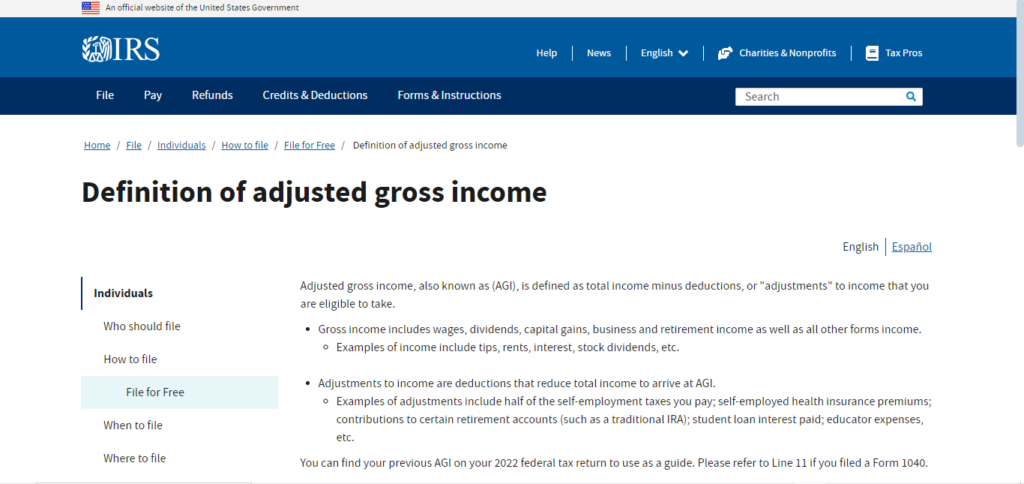What Is Adjusted Gross Income?

AGI or Adjusted Gross Income is a tool to determine the adjusted qualified expenses of the year to deduct from the total gross income earned by an individual during the FY. The IRS (Internal Revenue Systems) maintained and controlled the AGI.
Adjustments include business expenses, student loan interest, or investment in any community projects. Individuals can apply for a different number (modified AGI) to reinstate some special adjustment with the Gross Income to pay the taxes (accordingly).
The AGI number is just like a credit score. It helps the IRS determine your eligibility for some special retirement plans. An AGI number carries a significant weightage, that can affect a few special retirement plans, such as the Roth Individual Retirement Account.
The MAGI is another number that can give you some additional adjustment deduction. It means you enjoy saving an excess amount of wealth from taxes. According to the IRS, gross income is anything related to dividends on shares, capital gains, and salary. It includes indirect income like rent, stock dividends, wages, interest, etc.
The IRS defined the adjustments deductions include self-employed tax payment (half) and health insurance premiums, or contributions to some of the retirement accounts mentioned above. Other expenses include student loans and educator expenses.
Modified AGI vs Adjusted Gross Income

AGI: Adjusted gross income applied to your total gross income which includes dividends, self-employed retirement plan, alimony payment (divorce pair agreement 2019), and half of the taxes paid by self-employed status.
MAGI: Modified adjusted gross income applied as an additional deduction (that you) “must apply for to add back”. Those are retirement plan contributions, IRS contributions, school fees, tutor fees, etc.
AGI: It is like a credit score that can affect several credit adjustment eligibility criteria. That includes child and department care credits, child tax credits, elderly or permanently disabled credits, and the earned income tax credit.
MAGI: The MAGI number is an extra layer of confirmation of your eligibility criteria for certain add-back adjustment deductions.
Learn to Calculate the (AGI) Adjusted Gross Income
Interestingly this required only 2 steps. Let’s begin.
- Collecting all the income receipts related to salary, self-employed, dividend, etc. mentioned in the Form 1099. Then add all the income recipes to arrive at gross income.
- Apply for the eligible deduction to subtract the savings from your gross income.
Let’s understand in detail.
Step #1. Collecting and adding all the income receipts mentioned in the form 1099
First, you need to collect all the receipts related to income for the respective financial year. This includes profit on dividends, capital gain, rent, interests, etc. The traditional income included salary and wages according to the “form W-2”. If the income related to profit on self-employed ventures should be included on the form 1099.
Income-related to broker and broker exchange should be applied on form 1099-B. Proceeds related to real estate transactions should be included in form 1099-S and income from the interest in form 1099-INT. In the form 1099-DIV, only the income from the transaction of investment dividend is added.
The List of Taxable Income
This is the list of income applicable for tax under the law those are;
| Profit for businesses |
| Farm revenue |
| benefits of the union strike |
| Refunds, credits, and other taxable amounts that balance state and local income taxes |
| Jury duty fees Long-term disability benefits obtained before the minimum retirement age |
| Income from rental properties and security deposits |
| Prizes, awards, lotteries, gaming, and contest winnings |
| Refunds from lawsuits involving labor discrimination |
| Benefits for unemployment |
| Capital gains |
| Pay for severance |
| Revenue from license fees, partnerships, S companies, rental real estate, and royalties |
Just aggregate the amount and keep it aside for the deductions.
Step #2. Apply for the eligible deduction (AGI) to subtract
Now carefully search through the norms mentioned adjustments for deductions to subtract from your gross income. We provide some of the most common lists of adjustments that are eligible for deductions.
| The employer-equivalent portion of the (self-employment tax is half ) 7 Teachers’ and educators’ expenditures in the classroom may be up to $300, or $600 if they file jointly and both spouses are eligible educators. |
| payments for self-employed health insurance, even if your spouse and dependents are covered9. |
| contributions made to specific retirement plans |
| Interest on student loans is paid |
| Health savings account (HSA) contributions10 |
| Moving costs for active military personnel |
| Penalties for early savings withdrawals |
| Some reservists’, performers’, and fee-basis government officials’ business costs |
Note: Whenever calculating the among be careful because it needs to be eligible before your claim for the relatable adjustment.
Untaxable Income

You will relieved to know about certain categories of income, that don’t fall under the umbrella of taxation which are given below in the table.
| Benefits from workers’ compensation |
| Benefits of child support |
| Proceeds from life insurance, unless you were paid to turn over the policy |
| benefits for disabilities |
| Gains on the sale of your principal residence Capital gifts or other inherited properties |
| Canceled obligations that were meant to be a gift to you |
| Grants for fellowships or scholarships |
| Foster care reimbursements |
| Rollover funds between retirement accounts as long as they are transferred between trustees6 Internal Revenue Service. “Publication 525 (2023), Taxable and Nontaxable Income.” |
Now let’s know about the forms W-2, 1099, and 1099-B, INT, DIV, and S. Therefore you have an idea of which form needs to be filled for different categories of income.
What is Form 1099-B?
If you are a broker working in the stock exchange or recently sold some goods through the barter system then this form 1099-B is for you. The form is specifically for those who earn income from broking or the barter system. This information is later transferred to form 8949 and the result is recorded under Schedule D.
What is Form W-2?
This form is for the salaried individual who engages in any kind of trade transaction or paying remuneration (including non-cash expenses worth $600 for more than a year. Any income related to Social Security or Medicare shall be withheld.
What are Form 1099-Div, S, and INT?
1099 Div is for the income related to earnings from investment dividends.
1099 INT is for interest earned from rent, housing, property, etc.
1099-S is for the record of the income earned from selling real estate or foreign transfer exchange.
Conclusion
AGI or Adjusted Gross Income is a basic process of paying taxes maintained by the IRS or Internal Revenue Service of the USA. This is a basic mode of paying taxes. The filling for AGI is easy, and not complicated. There are different forms available for various categories of income.
AGI (number) deducted from the gross income earned in a financial year. MAGI is an additional modified adjustment applied while you are found eligible. Therefore, before you make any claim make sure to recheck the amount of your gross income for AGI.
